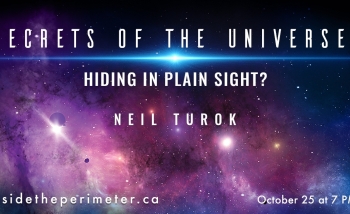Science for all
When asked why he wanted to deliver a public lecture at Perimeter Institute, Jon Butterworth responded without hesitation: “What’s the point of adding to new knowledge if you’re the only one who knows it?”
Butterworth, a physics professor at University College London who played a prominent role in the detection of the Higgs boson at the Large Hadron Collider, exemplifies an outlook typical among speakers in Perimeter’s long-running lecture series. “There’s a wonder in this exploration that ought to be shared,” he says.
This year, the Perimeter Institute Public Lecture Series, presented by Sun Life Financial, was shared with more people than ever before. The series returned home to Perimeter’s Mike Lazaridis Theatre of Ideas, where it is now webcast live. It was also shared on the websites of media partners including Scientific American, Maclean’s, CBC, Space.com, and more, reaching an audience of thousands in more than 30 countries.
Here are some highlights from the 2014/15 season:
Quantum Entanglement and Superconductivity
Subir Sachdev - October 1, 2014
In a nutshell: Though Einstein described the effects of quantum entanglement as “spooky,” Sachdev explained why he prefers to describe entanglement as “useful.” Perimeter’s James Clerk Maxwell Chair in Theoretical Physics (Visiting) described research at the forefront of entanglement and superconductivity, which may lead to transformative advances in communications, transportation, medicine, and beyond.
Noteworthy moment: The spillage of liquid nitrogen onstage in preparation for a demonstration of quantum levitation. No toes were frozen in the making of this lecture.
Quotables: “I’m a theorist, so I might screw this up,” said Sachdev, moments before the liquid nitrogen spillage. Immediately afterward, when no harm was done, he added, “Physics is fun!”
“What I hope you’ll take away is some new understanding of what quantum mechanics is really and why it’s so important. You won’t be bored. You might be confused a little bit, but you won’t be bored.”
Quantum Mechanics and Spacetime in the 21st Century
Nima Arkani-Hamed - November 6, 2014
In a nutshell: A talk as wide-ranging and energetic as Arkani-Hamed’s cannot be encapsulated in a nutshell, as it covered, among other things, supersymmetry, string theory, particle colliders, and philosophy. Because the talk ran to 85 minutes instead of the intended 60, the Q&A portion was moved to Perimeter’s atrium, where Arkani-Hamed, a faculty member at Princeton's Institute for Advanced Study, happily answered questions from a large circle of curious attendees.
Noteworthy moment: Arkani-Hamed’s kinetic enthusiasm was infectious, and his hand-drawn PowerPoint slides (featuring cute stick figures) added to the oddball appeal.
Quotables: “Spacetime is doomed. What will replace it?”
“This is a singularly exciting time in the history of fundamental physics. I don’t say that lightly. It’s time for some revolutionary ideas. The questions on the table now are the deepest ones – the ones about the origin and fate of our universe.”
Interstellar Voyaging: An Evolutionary Transition
Cameron Smith - December 3, 2014
In a nutshell: If humans were to travel to another planet or solar system, the journey and settlement would take generations. Smith, an anthropologist at Portland State University, looks to clues from the past about human evolution – both biological and cultural – to understand what our spacefaring descendants might face.
Noteworthy moment: Smith’s recounting of his first-hand experiences studying other cultures, such as eating mummified sheep’s face and fermented shark meat that had been buried in sand for months (both delicacies in Iceland, where Smith has trekked solo across vast ice fields).
Quotables: “We have seen a lot of things go from science fiction to science fact. One will be our ability to go to exoplanets. It’s not the abandonment of Earth. It’s the preservation of humanity.”
“Rockets and robots are just tools. What we need is our humanity.”
Cosmology in the 21st Century
Kendrick Smith - February 4, 2015
In a nutshell: Smith, a Faculty member at Perimeter, gave himself a daunting task: to deliver a kind of “State of the Universe Address” in just 60 minutes. By all accounts, he succeeded, explaining how theoretical and experimental cosmology are on the verge of transformative insights into “some of the oldest, most self-motivated questions in science.”
Noteworthy moment: After showing dozens of highly detailed scientific slides about astrophysical measurements, Smith showed a map of sophisticated-experiment sites across Canada. Also on the cartoon map: orcas, beavers, turtles, and a moose whose gait straddled most of northern Manitoba.
Quotables: “Because we can see billions of light years away, we can see backwards in time. You experience a form of time travel.”
“We don’t live in a special place in the universe. We do live in a special time.”
Water Stress: Seeking Solutions in the Unusual Properties of Water
Marcia Barbosa - March 4, 2015
In a nutshell: Our most precious natural resource is also dangerously scarce for millions of people. Marcia Barbosa, Director of the Physics Institute at the Universidade Federal do Rio Grande do Sul, believes a better understanding of the physics of water might alleviate water stress. Barbosa’s unbridled enthusiasm (despite being a Brazilian visiting Waterloo during its coldest winter on record) made for a stirring, memorable talk.
Noteworthy moment: In what must have been a first for Perimeter public lectures, a physicist suggested that the solution to a difficult problem (desalinating water) might be found in the body of a creepy-crawly black beetle in Africa, which inspired the creation of a “nanotube beetle.”
Quotables: “Water is crazy. In a certain range of temperatures, water goes bananas.”
“Hydrogen bonds are flirty.”
The Most Wanted Particle
Jon Butterworth - April 1, 2015
In a nutshell: The hunt for the Higgs boson was one of the biggest and most publicized scientific undertakings in human history, and Jon Butterworth is a leader of research at the Large Hadron Collider’s ATLAS detector. Butterworth mixed hard science with personal anecdotes in a smashing public lecture that conveyed the hopes, frustrations, and ultimate celebrations of the search for an elusive piece of nature’s puzzle.
Noteworthy moment: Butterworth showed a series of images, both aerial and on the ground, that depict the sheer immensity of the 27-kilometer LHC – and how it may one day be dwarfed by the proposed Future Circular Collider.
Quotables: “We said, ‘What is this? Is this the Higgs?’ We knew we were onto something.”
“You could fit all of central London into the ring of the LHC – London, England, I mean, not London, Ontario.”
String Theory Legos for Black Holes
Amanda Peet - May 6, 2015
In a nutshell: Peet, a string theorist at the University of Toronto, explained key concepts of string theory using the colorful building blocks of Lego. Peet’s infectious energy and hands-on Lego demonstrations kept the audience rapt.
Notable moment: Peet was unflappable when fielding questions during the post-talk Q&A, and provided some encouragement to a young boy with a vexing query: “I may be wrong, so maybe 10 years from now you’ll prove me wrong by writing a paper about this.”
Quotables: “I’ve dared myself to explain this abstract theoretical physics to the lay public. So buckle your seatbelts, sit back, and enjoy the ride.”
“We are daring to seek the operating system of the entire universe, not just a killer app.”
About PI
Perimeter Institute is the world’s largest research hub devoted to theoretical physics. The independent Institute was founded in 1999 to foster breakthroughs in the fundamental understanding of our universe, from the smallest particles to the entire cosmos. Research at Perimeter is motivated by the understanding that fundamental science advances human knowledge and catalyzes innovation, and that today’s theoretical physics is tomorrow’s technology. Located in the Region of Waterloo, the not-for-profit Institute is a unique public-private endeavour, including the Governments of Ontario and Canada, that enables cutting-edge research, trains the next generation of scientific pioneers, and shares the power of physics through award-winning educational outreach and public engagement.


